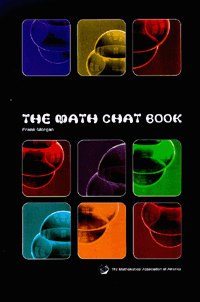- About MAA
- Membership
- MAA Publications
- Periodicals
- Blogs
- MAA Book Series
- MAA Press (an imprint of the AMS)
- MAA Notes
- MAA Reviews
- Mathematical Communication
- Information for Libraries
- Author Resources
- Advertise with MAA
- Meetings
- Competitions
- Programs
- Communities
- MAA Sections
- SIGMAA
- MAA Connect
- Students
- MAA Awards
- Awards Booklets
- Writing Awards
- Teaching Awards
- Service Awards
- Research Awards
- Lecture Awards
- Putnam Competition Individual and Team Winners
- D. E. Shaw Group AMC 8 Awards & Certificates
- Maryam Mirzakhani AMC 10 A Awards & Certificates
- Two Sigma AMC 10 B Awards & Certificates
- Jane Street AMC 12 A Awards & Certificates
- Akamai AMC 12 B Awards & Certificates
- High School Teachers
- News
You are here
Frank Morgan's Math Chat - Numbers on your Computer Screen
 |
 |
July 19, 2001
Old Challenge (Branislav Kisacanin). There are some positive numbers on my computer screen, and each of them is half the sum of the others. What could the numbers be?
Answer There must be exactly three numbers, and they must all be the same. If there were more than three, the smallest would be less than half the sum of the others. If there were just two, the larger would be more than half the other. If there was just one, it would be more than zero (half the sum of the others). Furthermore, if each of the three equals the average of the other two, all three must be equal. (Awards this week to first-time winners: Laurence Draper, Escantidu, Bappaditya Das, Todd Culbertson, and Sonny Kunnakkat.)
Al Zimmermann gives two other technically correct solutions: (1) there could be zero numbers on the screen, for which the condition holds vacuously; (2) there could be infinitely many infinities on the screen.
New Challenge (inspired by a walk across the campus of the University of California at Berkeley). If two houses on the side of a hill are at the same height, is there a path between them at that height, without going uphill or downhill?
A Mathematician at Heaven's Gate:
a play by Frank Morgan
continued from last column.
Last time our mathematician had finally made it into heaven's waiting room.
Scene III
He finds himself surrounded by the most wonderful toys you could imagine. One is a small counterexample to the Poincare conjecture. You could understand it at a glance, but playing with it gives the deepest intellectual satisfaction and joy. There is a model of the Weaire-Phelan partitioning of three-space, which includes a most marvelous proof at a glance. There is a multidimensional model in which all of the primes are visible from infinitely many sides, each exhibiting a beautiful property, from Goldbach's Conjecture to the Riemann hypothesis, all somehow visible at once. Most of the toys are beyond description.
He is soon approached by an enthusiastic welcoming party. Incredibly enough, he really is the first mathematician, and everyone is very interested. A woman speaks up:
"Before I came here, I was afraid of math. But now I'm not afraid of anything."
She shows him an infinite dimensional box with a theorem on every side, surrounded by theorems implying it or implied by it. He is entranced:
"Amazing. It makes the whole structure of geometry apparent in an instant."
Conclusion in the next Math Chat.
Copyright 2001, Frank Morgan.
Send answers, comments, and new questions by email to Frank.Morgan@williams.edu, to be eligible for Flatland and other book awards. Winning answers will appear in the next Math Chat. Math Chat appears on the first and third Thursdays of each month. Prof. Morgan's homepage is at www.williams.edu/Mathematics/fmorgan.
THE MATH CHAT BOOK, including a $1000 Math Chat Book QUEST, questions and answers, and a list of past challenge winners, is now available from the MAA (800-331-1622).




